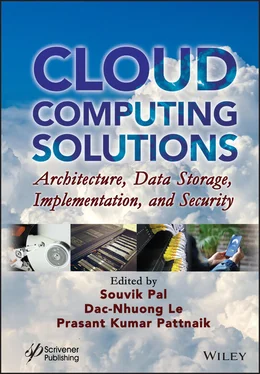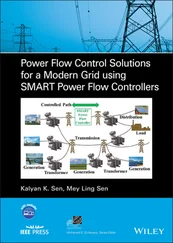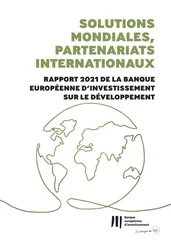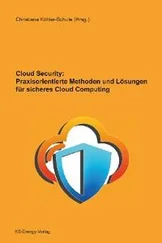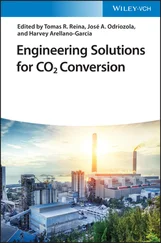Cloud Computing Solutions
Здесь есть возможность читать онлайн «Cloud Computing Solutions» — ознакомительный отрывок электронной книги совершенно бесплатно, а после прочтения отрывка купить полную версию. В некоторых случаях можно слушать аудио, скачать через торрент в формате fb2 и присутствует краткое содержание. Жанр: unrecognised, на английском языке. Описание произведения, (предисловие) а так же отзывы посетителей доступны на портале библиотеки ЛибКат.
- Название:Cloud Computing Solutions
- Автор:
- Жанр:
- Год:неизвестен
- ISBN:нет данных
- Рейтинг книги:3 / 5. Голосов: 1
-
Избранное:Добавить в избранное
- Отзывы:
-
Ваша оценка:
- 60
- 1
- 2
- 3
- 4
- 5
Cloud Computing Solutions: краткое содержание, описание и аннотация
Предлагаем к чтению аннотацию, описание, краткое содержание или предисловие (зависит от того, что написал сам автор книги «Cloud Computing Solutions»). Если вы не нашли необходимую информацию о книге — напишите в комментариях, мы постараемся отыскать её.
The main purpose of this book is to include all the cloud-related technologies in a single platform, so that researchers, academicians, postgraduate students, and those in the industry can easily understand the cloud-based ecosystems.
Audience
Cloud Computing Solutions — читать онлайн ознакомительный отрывок
Ниже представлен текст книги, разбитый по страницам. Система сохранения места последней прочитанной страницы, позволяет с удобством читать онлайн бесплатно книгу «Cloud Computing Solutions», без необходимости каждый раз заново искать на чём Вы остановились. Поставьте закладку, и сможете в любой момент перейти на страницу, на которой закончили чтение.
Интервал:
Закладка:
References
1. Foster, I. (2003). The grid: Computing without bounds. Scientific American, 288(4), 78-85.
2. Buyya, R., Yeo, C. S., Venugopal, S., Broberg, J., & Brandic, I. (2009). Cloud computing and emerging IT platforms: Vision, hype, and reality for delivering computing as the 5th utility. Future Generation computer systems, 25(6), 599-616.
3. McKinsey & Co. (2009). Clearing the Air on Cloud Computing, Technical Report, 2009. REFEREN CES 37
4. Vaquero, L. M., Rodero-Merino, L., Caceres, J., & Lindner, M. (2008). A break in the clouds: towards a cloud definition. ACM SIGCOMM Computer Communication Review, 39(1), 50-55.
5. Mell, P., & Grance, T. (2011). The NIST definition of cloud computing., Information Technology Laboratory, Technical Report.
6. Fox, A., Griffith, R., Joseph, A., Katz, R., Konwinski, A., Lee, G., ... & Stoica, I. (2009). Above the clouds: A berkeley view of cloud computing. Dept. Electrical Eng. and Comput. Sciences, University of California, Berkeley, Rep. UCB/EECS, 28(13), 2009.
7. L. Silva and R. Buyya (1999). Parallel Programming Models and Paradigms, High Performance Cluster Computing: Programming and Applications, Rajkumar Buyya (editor), ISBN 0-13-013785-5, Prentice Hall PTR, NJ, USA.
8. O’reilly, T. (2007). What is Web 2.0: Design patterns and business models for the next generation of software. Communications & strategies , (1), 17.
9. Mather, T., Kumaraswamy, S., & Latif, S. (2009). Cloud security and privacy: an enterprise perspective on risks and compliance. O’Reilly Media, Inc.
10. Sotomayor, B., Montero, R. S., Llorente, I. M., & Foster, I. (2009). Virtual infrastructure management in private and hybrid clouds. IEEE Internet computing , 13(5), 14-22.
11. Hurwitz, J. S., Bloor, R., Kaufman, M., & Halper, F. (2010). Cloud computing for dummies. John Wiley & Sons.
12. Pal, S., & Pattnaik, P. K. (2012). Efficient architectural framework for cloud computing. International Journal of Cloud Computing and Services Science, 1(2), 66.
13. Yang, J., & Chen, Z. (2010, December). Cloud computing research and security issues. In 2010 International Conference on Computational Intelligence and Software Engineering (pp. 1-3). IEEE.
14. Sarathy, V., Narayan, P., & Mikkilineni, R. (2010, June). Next generation cloud computing architecture: Enabling real-time dynamism for shared distributed physical infrastructure. In 2010 19th IEEE International Workshops on Enabling Technologies: Infrastructures for Collaborative Enterprises (pp. 48-53). IEEE.
15. Pal, S., Mohanty, S., Pattnaik, P. K., & Mund, G. B. (2012). A Virtualization Model for Cloud Computing, in the Proceedings of International Conference on Advances in Computer Science (AET _ACS_2012), December 2012, pp.10-16.
16. Vecchiola, C., Chu, X., & Buyya, R. (2009). Aneka: a software platform for .NET-based cloud computing. High Speed and Large Scale Scientific Computing , 18, 267-295.
17. Le, D. N., Kumar, R., Nguyen, G. N., & Chatterjee, J. M. (2018). Cloud Computing and Virtualization . John Wiley & Sons.
18. Le, D. N., Bhatt, C. M., & Madhukar, M. (Eds.). (2019). Security Designs for the Cloud, IoT, and Social Networking . John Wiley & Sons.
19. Mansouri, N., Ghafari, R., & Zade, B. M. H. (2020). Cloud computing simulators: A comprehensive review. Simulation Modelling Practice and Theory, 104, 102144.
20. Van, V. N., Long, N. Q., Nguyen, G. N., & Le, D. N. (2016). A performance analysis of openstack open-source solution for IaaS cloud computing. In Proceedings of the Second International Conference on Computer and Communication Technologies (pp. 141-150). Springer, New Delhi.
21. Van, V. N., Long, N. Q., & Le, D. N. (2016). Performance analysis of network virtualization in cloud computing infrastructures on openstack. In Innovations in Computer Science and Engineering (pp. 95-103). Springer, Singapore.
22. Hurwitz, J. S., & Kirsch, D. (2020). Cloud computing for Dummies. John Wiley & Sons.
23. Seth, B., Dalal, S., Jaglan, V., Le, D. N., Mohan, S., & Srivastava, G. (2020). Integrating encryption techniques for secure data storage in the cloud. Transactions on Emerging Telecommunications Technologies, e4108.
24. Prokhorenko, V., & Babar, M. A. (2020). Architectural resilience in cloud, fog and edge systems: A survey. IEEE Access, 8, 28078-28095.
25. Bohu, L., Lin, Z., & Xudong, C. (2020). Introduction to cloud manufacturing. ZTE Communications , 8(4), 6-9.
1 1 http://aws.amazon.com
2 2 http://gogrid.com/
3 3 https://www.rackspace.com
4 4 www.manjrasoft.com/aneka_architecture
5 5 https://cloud.google.com/appengine
3
ARCHITECTURAL FRAMEWORK FOR CLOUD COMPUTING
SOUVIK PAL 1, DAC-NHUONG LE 2, PRASANT KUMAR PATTNAIK 3
1Sister Nivedita University, Kolkata, India
2Haiphong University, Haiphong, Vietnam
3KIIT, Deemed to be University, India
Email: souvikpal22@gmail.com, nhuongld@dhhp.edu.vn, patnaikprasant@gmail.com
Abstract
Cloud is an internet-based concept that tries to hide its underlying complexity from end users. Cloud service providers (CSPs) use many structural designs combined with selfservice capabilities and ready-to-use facilities for computing resources, which are enabled through network infrastructure, especially in the internet, which is an important consideration. This chapter elaborately describes an efficient architectural framework for cloud computing that may lead to better performance and faster access.
This chapter focuses on the architectural framework along with the economic reasons like minimum investment on infrastructure, no need to assemble and maintain a largescale system, low computing costs and no need for employee investments. Due to these economic advantages, clients benefit from minimizing the execution time of user applications, including data-intensive and compute-intensive applications. Moreover, the application developers can get an interface or platform where they can derive pleasure from the use of immediate and ready-made infrastructure and can feel free to design the related applications without any overhead in terms of where the application will be executed.
From a business point of view, cloud computing has a great advantage of reducing setup cost for service providers. Cloud service providers set up the cloud infrastructure, including bare metal hardware resources, system and computing resources in the primary level. And after that they are able to provide the services to the clients according their requirements. On the other side, the cloud users get the services from the providers without setting up any cloud infrastructure and also without making any investments in that particular service; only they have to provide the payment according to their usage.
The aim of cloud computing is to make the relation easy between the clients and providers. Hence, a good cloud architectural framework is needed so that the clients can easily deploy their application on the cloud platform and get the chance to design and test their applications. Therefore, this chapter focuses on the cloud framework where multiple users can get cloud service from the providers and also can deploy their application on the cloud platform irrespective of which operating system they are using. The main hold of cloud computing is the ability to use several servers according to the requirements of the users to provide an optimal response to the cost and time constraints of an application. It can be possible when the workload can be divided into different data centers using the virtual machines discussed in this chapter.
Читать дальшеИнтервал:
Закладка:
Похожие книги на «Cloud Computing Solutions»
Представляем Вашему вниманию похожие книги на «Cloud Computing Solutions» списком для выбора. Мы отобрали схожую по названию и смыслу литературу в надежде предоставить читателям больше вариантов отыскать новые, интересные, ещё непрочитанные произведения.
Обсуждение, отзывы о книге «Cloud Computing Solutions» и просто собственные мнения читателей. Оставьте ваши комментарии, напишите, что Вы думаете о произведении, его смысле или главных героях. Укажите что конкретно понравилось, а что нет, и почему Вы так считаете.
